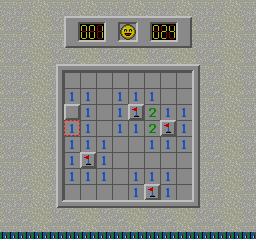During the 8-bit and 16-bit console era, most of the software development was done in Japan. But occasionally a Western computer game would appeal enough to Eastern sensibilities for a port to be developed. Most of these ports were dungeon-crawl RPGs, but puzzle games were also in the running. Sometimes this led to odd choices, like the PC Engine port of the game known by most people as the Windows freebie Mine Sweeper. This is an unusual case in terms of licensing -- Minesweeper and variations on the theme go back to the mainframe days, so a generic variant could have been produced just as easily. But here it is, and on the PC Engine's CD-ROM format, making ARC Co. and Pack-In-Video's version, if nothing else, probably the bulkiest edition ever produced.
The core game plays just like the Windows version with which most readers will be familiar, though without a mouse the interface is clunkier than the ideal. Each tile contains either a mine, or a number indicating how many mines are detected in the surrounding tiles. There's some guesswork involved, and some deductive strategy, making for a simple but compelling one-more-time play experience. And the CD-Audio soundtrack of this version is rich and varied.
This version justifies its retail existence by adding a couple of extra modes -- there's an Edit Mode allowing players to construct new puzzles, and two additional game modes:
The Voyage moves the game to a more realistic environment, kicking off with a battleship sunk by enemy mines and adopting a different graphical style, replacing modern mines with old-fashioned explosive barrels and markers with skulls. This mode is broken up into missions, with a password system for retaining progress; failure on any mission means the game is over, but the levels are not randomized so it's possible to win with patience and a good memory.
The Cook's Quest mode features some rather bizarre imagery that looks very strange indeed to Western eyes. It stars a little cook, who appears to be trying to tunnel out of someplace, pursued by a slow-moving boulder. Instead of safely marking all the mines on the screen, our goal is to find a safe path through the minefield to the exit and the next room, as quickly as possible.
What's strange is that the cook character resembles 1920's-vintage cartoon caricatures of African-Americans, right down to the "Wah!" sound he makes as the game begins and the boulder encroaches, except he's rendered in chalky whiteface:
And... erm... when a mine is discovered, it's portrayed as... a Star of David?!? Perhaps this mode is meant as some kind of metaphor about flour and unleavened bread, but I hesitate to speculate further. Japanese games of this era often featured insensitive racial and religious imagery, but usually the choices made sense from a certain perspective. This one leaves me speechless.
That's all there really is to say about Mine Sweeper. It's a competent version of a classic game, with some questionable visual choices that would certainly have been controversial if it had made it to North American shores. Fortunately, I think NEC realized that TurboGrafx-16 owners were not about to spend significant money on a game included free with Windows 3.1, and in this case we're probably better off for it.
If you really must pay good money for a game whose most popular versions were free, you might be able to find a copy of this console port here.







The is six-pointed star is often seen as a symbol of magic or sorcery in Japanese games, much like the five-pointed pentagram is used in Western games (like the Ultima series). I have never figured out why this is so.
ReplyDeleteInteresting -- thanks for the insight! There's no apparent indication that this is meant to be a magical symbol, but there's also no indication that it's meant to be a religious symbol. Maybe our little cook friend is meant to be fleeing from demons -- we never see who's pushing the rock at the other end of the tunnel. It's just a very strange mode all around.
ReplyDelete